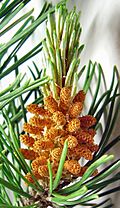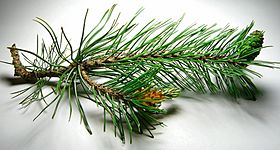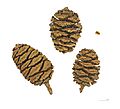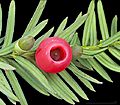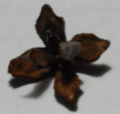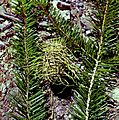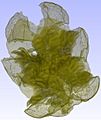Conifer cone facts for kids
A cone is a special part on plants like conifers (think pine trees!). It holds the parts needed for the plant to reproduce. The woody cones you often see are the female cones. They produce seeds. Male cones are usually smaller and softer. They make pollen. The name "cone" comes from its shape, which looks like a geometric cone.
The male cone (also called a pollen cone) looks similar across all conifers. It has a central stem with small, modified leaves called microsporophylls. Under each of these leaves are tiny sacs called microsporangia. These sacs are where the pollen is made. The picture on the right shows male pine cones right after they have released their pollen.
The female cone (also called a seed cone) holds the ovules. When pollen fertilizes these ovules, they grow into seeds. Female cones look different depending on the type of conifer. This often helps people identify different conifer species.
Contents
Female Cones of Conifer Families
Pine Family Cones
Trees in the pine family include pines, spruces, firs, and cedars. Their cones have scales that overlap like fish scales. These are the classic "pine cones" you probably know. The scales are arranged in a spiral pattern.
A female cone has two types of scales. There are bract scales (like modified leaves) and seed scales. Each seed scale sits below a bract scale. On the top of each seed scale are two ovules. These ovules become seeds after pollen fertilizes them. The scales open to catch pollen. Then they close to protect the developing seeds. When the seeds are ready, the scales open again to let them out. This process can take from 6 months to over 2 years, depending on the tree. Some cones open by their scales bending back when dry. Others, like fir cones, break apart to release their seeds. These cones can be small or very large, from 2 to 60 cm long.
Araucariaceae Cones
Trees in the Araucariaceae family include Araucaria and Agathis. Their cones have bract and seed scales that are completely joined together. Each scale has only one ovule. These cones are usually round and very large, from 5 to 30 cm across. They take about 18 months to mature. When they are ready, they break apart to release their seeds. In Agathis trees, the seeds have wings. In other trees like Araucaria, the seeds do not have wings and are attached to the scale.
Podocarpaceae Cones
The cones of the Podocarpaceae family look like berries. Their scales are very changed and are designed to attract birds. Birds help spread the seeds. In most of these trees, several scales join together to form a soft, colorful, edible fruit. Usually, only one or two scales at the top of the cone can produce seeds. Each of these fertile scales holds a single seed without wings. The fleshy part can be 0.5 to 3 cm long. The seeds have a hard coating. This helps them survive digestion in a bird's stomach. The seeds are then passed in the bird's droppings, spreading them far away.
Cypress Family Cones
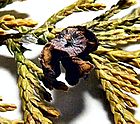
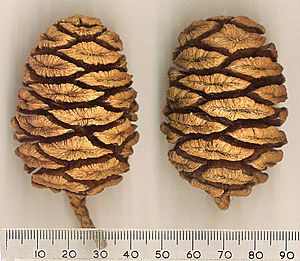
Trees in the cypress family include cypresses, arborvitae, and junipers. In these cones, the bract and seed scales are completely joined. You might only see the bract as a small bump on the scale. Sometimes, the term galbulus is used for these cones. Female cones can have from one to 20 ovules on each scale. Their scales are often shield-shaped, but some are overlapping. These cones are usually small, from 0.3 to 6 cm long. They are often round, like those of Nootka Cypress. Other cones, like Western Redcedar, are narrow. The scales can be arranged in spirals or in pairs or groups of three. In most cypress trees, the cones are woody. Their seeds have two small wings. But in some types like Juniperus, the seeds have no wings. In junipers, the cones are soft and look like berries.
Sciadopityaceae Cones
The cones and seeds of Sciadopitys (the only tree in its family) are similar to some cypress cones. However, they are larger, from 6 to 11 cm long. Their scales overlap and are arranged in a spiral. Each scale has 5 to 9 ovules.
Yew and Cephalotaxaceae Cones
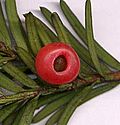
Trees in the yew family and the related Cephalotaxaceae have the most changed cones of all conifers. Their female cone has only one scale with a single ovule. This scale grows into a soft, colorful, sweet, and juicy berry-like covering called an aril. This aril partly surrounds the seed. Birds eat the whole "berry." They digest the sugary aril and then pass the hard seed in their droppings. This helps spread the seeds far away from the parent plant.
Where Cones Grow
Most conifer trees have both male and female cones on the same plant. The female cones are usually on the higher branches, near the top of the tree. This helps with cross-pollination. Pollen from male cones is less likely to blow straight up to female cones on the same tree. Instead, the wind can carry pollen from a lower part of one tree to a higher part of another tree. This helps different trees share their genetic material. Male cones often grow in large groups, while female cones are usually found alone or in small groups.
In pine trees, male cones are usually at the base of a branch. Female cones are at the tip of the same branch or a different one. In larches and cedars, both types of cones are always at the tips of short shoots. In fir trees, both male and female cones grow from side buds, not at the very end of a branch. Some cypress trees, like Cupressus, have male and female cones in similar places.
Conifer cones and their seeds have many uses. People often use them for decorations. Some seeds, like those from pinyon pines, are eaten in foods and baking.
Most mature cones close up when they get wet and open when they dry out. This helps them protect and release their seeds. For a few types of trees, fire is needed to make their cones open.
Images for kids
-
A mature female Coulter pine (Pinus coulteri) cone, the heaviest pine cone
-
Rocky Mountain Douglas-fir (Pseudotsuga menziesii var. glauca) young female cone
-
Immature male or pollen cones of Rocky Mountain ponderosa pine. (Pinus ponderosa var. scopulorum)
-
Young cones of a Blue Spruce
-
Araucaria angustifolia cones and nuts
-
Giant Sequoia cones
-
Berry-like yew cone
-
Berry-like cones of common juniper (Juniperus communis)
-
A pine cone covered in ice after an ice storm.
-
Female cone of a lebanese cedar
-
Pineapple gall on Sitka Spruce caused by Adelges abietis.
-
Blue spruce with cones
-
Young female cones of loblolly pine receptive for pollination.
-
Loblolly pine male cones ready to cast pollen.
-
Cross section of maturing shortleaf pine cone showing seeds (arrows).
-
Loblolly pine branch with cones of different ages; 2-yr old cones will disperse seeds during fall and winter.
-
Cluster of Norway Spruce cones on Hokkaidō.
-
Arborvitae cone.
-
Pine cones jam (Ukraine).
-
Pinus canariensis male cone in Gran Canaria.
-
The cone structure of Abies bracteata
See also
 In Spanish: Cono (botánica) para niños
In Spanish: Cono (botánica) para niños



